Abstract
The long-term effect of protection by two doses of SARS-CoV-2 vaccination in patients receiving chronic intermittent hemodialysis (CIHD) is an urging question. We investigated the humoral and cellular immune response of 42 CIHD patients who had received two doses of SARS-CoV-2 vaccine, and again after a booster vaccine with mRNA-1273 six months later. We measured antibody levels and SARS-CoV-2-specific surrogate neutralizing antibodies (SNA). Functional T cell immune response to vaccination was assessed by quantifying interferon-γ (IFN-γ) and IL-2 secreting T cells specific for SARS-CoV-2 using an ELISpot assay. Our data reveal a moderate immune response after the second dose of vaccination, with significantly decreasing SARS-CoV-2-specific antibody levels and less than half of the study group showed neutralizing antibodies six months afterwards. Booster vaccines increased the humoral response dramatically and led to a response rate of 89.2% for antibody levels and a response rate of 94.6% for SNA. Measurement in a no response/low response (NR/LR) subgroup of our cohort, which differed from the whole group in age and rate of immunosuppressive drugs, indicated failure of a corresponding T cell response after the booster vaccine. We strongly argue in favor of a regular testing of surrogate neutralizing antibodies and consecutive booster vaccinations for CIHD patients to provide a stronger and persistent immunity.
Keywords:
COVID-19; SARS-CoV-2; vaccination; hemodialysis; booster; mRNA-1273; seroconversion; T cell response 1. Introduction
The current coronavirus disease 2019 (COVID-19) pandemic confronts our society with a global threat that particularly concerns patients with compromised immune systems, either due to immunosuppressive therapy or diseases associated with impaired immune response. Patients with end-stage renal disease (ESRD) undergoing chronic intermittent hemodialysis (CIHD) are affected by lower humoral and cellular immunity [1]. For this reason, severe acute respiratory syndrome coronavirus-2 (SARS-CoV-2) infection and chronic dialysis patients make a particular dangerous relationship. Patients undergoing CIHD represent a vulnerable population which are at an increased risk of SARS-CoV-2 infection and threatened by an almost four-fold higher mortality rate compared to the general population [2,3]. Thus, CIHD patients were prioritized for early SARS-CoV-2-vaccination in several countries [4]. Sahin et al. showed that vaccination with BNT162b2 (Tozinameran, BioNTech/Pfizer, Mainz, Germany/New York, NY, USA) induced both a strong antibody and T cell response in healthy adults [5,6]. However, recent data reveal a significantly lower SARS-CoV-2 spike protein antibody titer and reduced vaccination success rates of patients receiving CIHD compared to the general population after vaccination with BNT162b2 [7]. An effective short-term seroconversion rate after SARS-CoV-2 vaccination in the CIHD population was shown but recently published results indicate rapidly decreasing SARS-CoV-2-specific antibody levels in the long term [8]. There is evidence for a beneficial effect of a third dose of a COVID-19 mRNA vaccine on antibody titers in this specific high-risk population [9] and, in addition to the humoral immune response, T cells may also contribute to a protective immunity against SARS-CoV-2 and improve vaccine efficacy [10,11]. However, data regarding cellular immune response in this cohort are scarce.
Here, we investigated the initial SARS-CoV-2-specific serological and functional T cell immune response after two doses of SARS-CoV-2 vaccination (either BNT162b2 or ChAdOx1 (AstraZeneca, Cambridge, UK)) and its longevity during a time course of up to six months after the second dose in a cohort of high-risk CIHD patients in a tertiary care dialysis unit. In addition, we analyzed antibody titers and surrogate neutralizing antibodies (SNA) after a third dose, often referred to as booster vaccination, with Spikevax (mRNA-1273, Moderna, Cambridge, MA, USA) and measured its effect on the SARS-CoV-2-reactive T cell response in a subgroup of CIHD patients with no response/low response (NR/LR) (n = 10) after their second vaccination.
2. Materials and Methods
2.1. Study Design and Cohorts
In a prospective, non-interventional study approach, 42 long-term dialysis patients were observed from January 2021 to December 2021 in a tertiary care dialysis unit at the Department of Nephrology and Dialysis at Frankfurt University Hospital (Frankfurt, Germany). A healthy control group (n = 11; median (IQR) age 34 years (26–49), 27.3% male) was included to compare cellular immune responses after immunization with two doses of BNT162b2 (BioNTech/Pfizer) mRNA vaccine.
Antibody levels and SNA were measured four weeks after the second dose (=t0, either with BNT162b2 or ChAdOx1), six months after second dose (=t1) and 14 days after a third dose (=t2, booster vaccine) of mRNA-1273 (Moderna) (Figure 1), exploring the time course of SARS-CoV-2-specific antibody levels and the percentage of neutralizing antibodies after vaccination against SARS-CoV-2 during the COVID-19 pandemic.
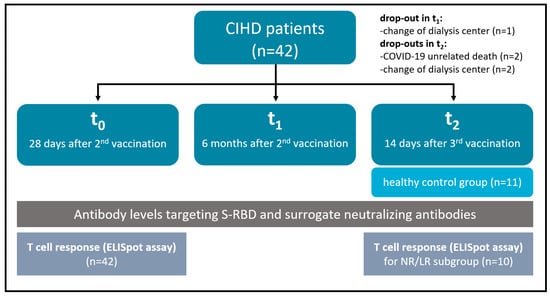
Figure 1.
Illustration of the study setup. Samples were collected at three different time points to evaluate the dynamic of the patients’ immunization status by different immunoassays. Abbreviations: CIHD (chronic intermittent hemodialysis); S-RBD (spike receptor binding domain); ELISpot (enzyme-linked immunospot).
The study was conducted in accordance with the principles of the Declaration of Helsinki and approved by the local ethics committee (reference number: 20/658). All study participants provided written informed consent before study entry.
2.2. Assessment of SARS-CoV-2-Specific Antibodies
Levels of antibodies targeted against SARS-CoV-2 spike receptor binding domain (S-RBD) were measured with a chemiluminescent microparticle based immunoassay (SARS-CoV-2 IgG II Quant, Abbott GmbH, Wiesbaden, Germany). Results are expressed as standardized binding antibody units (BAU)/mL. According to the manufacturer, a cut-off for positivity is set to 7.1 BAU/mL. We elevated the cut-off to 8.52 BAU/mL by adding a “threshold” range in between.
2.3. Assessment of SARS-CoV-2-Specific Surrogate Neutralizing Antibodies (SNA)
The binding of S-RBD to angiotensin-converting enzyme 2 allowing detection of SARS-CoV-2-neutralizing antibodies was performed using the ELISA-based GenScript SARS-CoV-2 Surrogate Virus Neutralization Test Kit (GenScript Biotech, Piscataway Township, NJ, USA) [12]. Results are expressed as percentage inhibition (%-INH).
2.4. Assessment of Cytokine-Producing SARS-CoV-2-Reactive T Cell Responses
The adaptive immune response was analyzed by quantifying interferon-γ (IFN-γ) and IL-2 secreting T cells specific for SARS-CoV-2 using a multicolor fluorescence enzyme-linked immunospot (ELISpot) assay (CoV-iSpot, AID GmbH, Strassberg, Germany) [13]. Highly specific sequences of immunodominant epitopes of SARS-CoV-2 structural proteins (=SARS-CoV-2-peptide-mix) were used for stimulation of T cells. Results are expressed as spot forming cells (SFC)/106 lymphocytes.
2.5. Statistics
Continuous variables are shown as median and interquartile range (IQR), categorical variables are reported as frequencies and percentages. Differences between patient cohorts were determined using the Fisher’s exact test for categorical variables; for quantitative variables, a t-test or a Mann–Whitney-U test was used for parametric and nonparametric data, respectively. When comparing more than two groups, one-way ANOVA followed by Bonferroni’s post hoc correction or Kruskal–Wallis test followed by Dunn´s post hoc test was performed for parametric and nonparametric data, respectively. For the comparison of related samples comprising more than two groups, a Friedman test was performed. Spearman´s rank correlation analysis was used to determine bivariate relationships by calculating Spearman´s Rho (correlation coefficient). Normality was assessed by a Kolmogorov–Smirnov test. All p-values reported are two-sided, the level of significance was set p < 0.05. Statistical analyses were performed using GraphPad Prism version 9.3.1 (GraphPad Software, San Diego, CA, USA) and BiAS (v11.01; epsilon-Verlag, Nordhasted, Germany).
3. Results
3.1. Basic Study Cohort Characteristics
We prospectively enrolled 45 CIHD patients, of which 42 met inclusion criteria, with a median (IQR) age of 62 (52–72.5) years. Three patients were excluded due to SARS-CoV-2 positivity (real-time reverse transcriptase PCR). The main clinical and demographic characteristics are depicted in Table 1. Due to the incidence of comorbidities, this study cohort is representing a highly vulnerable CIHD group. Five patients were not available for follow-up because of death unrelated to COVID-19 (n = 2, sepsis and cardiac arrest) and change of the dialysis center (n = 3). We observed a good vaccine tolerability, without serious adverse events in this cohort. No patient developed critical side effects or was hospitalized.

Table 1.
Baseline patient characteristics. NR/LR (no response/low response) group with insufficient humoral response after two doses of SARS-CoV-2 vaccine (t0). Abbreviations: m (male); GN (glomerulonephritis); ADPKD (autosomal dominant polycystic kidney disease); Tx (transplant). Data expressed as number (n) and percentage (%) or median (med) and interquartile range (IQR), respectively.
3.2. Dynamics of Antibody Levels in Vaccinated Dialysis Patients
Four weeks after the second dose of vaccination (=t0), 37 patients (88.1%) developed antibodies against the SARS-CoV-2 spike protein with a median (IQR) of 128 BAU/mL (43–1027.5), and 32 patients (76.2%) showed functional neutralizing capacity of SNA with a median (IQR) of 69%-INH (15–89), above the predefined threshold for positivity (>8.52 BAU/mL and >30%-INH, respectively; Figure 2).
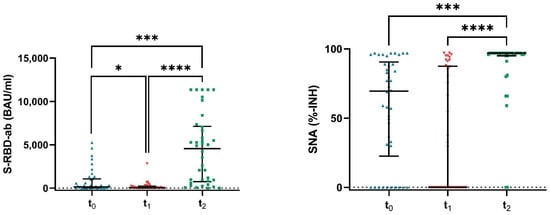
Figure 2.
Antibody response in plasma samples of patients taken at three different time points (t0 = four weeks after second dose, t1 = six months after second dose and t2 = 14 days after third dose (=booster vaccine) of mRNA-1273 (Moderna)). Abbreviations: S-RBD-ab (spike receptor binding domain-antibodies); SNA (surrogate neutralizing antibodies). Data are expressed as median (IQR). * p ≤ 0.05, *** p ≤ 0.001, **** p ≤ 0.0001 (Friedman test).
During the six-month period, the response rate of positive serology did not change (87.8%) but antibody levels decreased significantly compared to t0 (median (IQR) of 32.3 BAU/mL (9.9–224.1), p < 0.014). Less than half of this study group showed neutralizing antibodies (48.8%) with a median (IQR) of 0%-INH (0–87.8) six months after the second dose of the vaccine. Measuring antibody levels and SNA after the booster vaccine (=t2), we observed a significant elevation compared to timepoint t0 (p < 0.001) and t1 (p < 0.001) with a response rate of 89.2% for antibody levels (median (IQR): 4560 BAU/mL (646.7–7272.5)) and a response rate of 94.6% for SNA (median (IQR) of 97%-INH (0–97)). This corresponds to a 36-fold increase in median antibody titers after the third dose compared to t0.
To get a more detailed insight into the distribution of the humoral immune response we predefined different threshold values depending on the level of antibodies or neutralization capacity. Applying these antibodies and SNA cut-off levels (<100 BAU/mL or <50%-INH, no response/low response; 100–500 BAU/mL or 50–70%-IHN, moderate response; >500 BAU/mL or >70%-IHN, strong response) the overall response rates at t0, t1 and t2 are described in Figure 3, demonstrating a significant reduction in the humoral immunity six months after the second dose of the vaccine (=t1), followed by a distinct increase two weeks after the booster vaccine (=t2) with a significant difference, respectively.
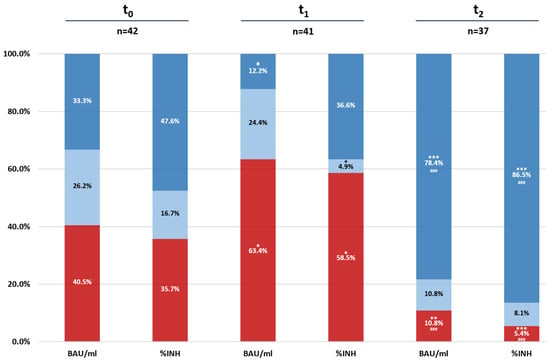
Figure 3.
Proportion of patients with strong (dark blue: >500 BAU/mL or >70%-INH), moderate (light blue: 100–500 BAU/mL or 50–70%-INH) and no/low (red: <100 BAU/mL or <50%-INH) humoral response at the three different time points (t0, t1 and t2). Data are expressed as percentage. * p ≤ 0.05, ** p ≤ 0.01, *** p ≤ 0.001 compared to t0; ### p ≤ 0.001 compared to t1.
The neutralizing capacity of SARS-CoV-2-specific antibodies is even more important than only the magnitude of antibody levels. For this reason, we analyzed the fraction of neutralizing capacity for different antibody levels, as illustrated in Figure 4. Data from our study group reveal that levels of SARS-CoV-2-spike-specific antibodies are significantly correlated with the percentage of SNA (t0 rho: 0.83; p < 0.001; t1 rho: 0.9; p < 0.001 and t2 rho: 0.58; p < 0.001).
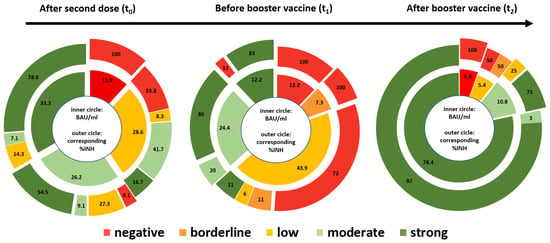
Figure 4.
Fraction of neutralizing capacity for different antibody levels. The inner circle is showing levels of antibody response (BAU/mL) with the corresponding percentage of neutralizing antibodies (%-INH) in the outer circle for t0, t1 and t2, respectively. Data are expressed as percentages. Applying the following antibody and SNA cut-off levels: negative (<7.1 BAU/mL or <30%-INH), borderline (>7.1–8.5 BAU/mL or >30–35%-IHN), low (>8.5–100 BAU/mL or >35–50%-INH), moderate (>100–500 BAU/mL or >50–70%-INH), strong (>500 BAU/mL or >70%-INH).
3.3. T Cell Response after Vaccination
Four weeks after the second dose, SARS-CoV-2-specific T cell reactivity of CIHD patients showed significantly lower levels of IFN-γ release compared to the healthy control group (HC, n = 11) (median (IQR) 7.5 SFC/106 cells (2.5–42.5) vs. 72.5 SFC/106 cells (21.25–101.25) (p < 0.001)), but no difference in IL-2 release between both groups (median (IQR) 40 SFC/106 cells (8.75–111.25) vs. 47.5 SFC/106 cells (28.75–68.75) (p < 0.001)); Figure 5. A positive IFN-γ release was only observed for nine patients (21.4%). A positive release of IL-2 after the booster vaccine occurred in 17 patients (40.5%).
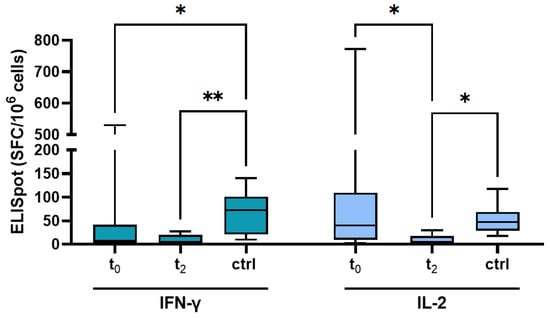
Figure 5.
Cytokine profile of T cell response specific to SARS-CoV-2 at different time points and in comparison to a healthy control group. Abbreviations: ELISpot (enzyme-linked immunospot); ctrl (control); IFN-γ (Interferon-γ); IL-2 (Interleukin-2). Data are expressed as median (IQR). Intragroup paired analysis: * p ≤ 0.05, ** p ≤ 0.01 as indicated (Kruskal–Wallis test).
We measured the T cell response again after the booster vaccination (t2) in a no response/low response NR/LR subgroup (n = 10) of t0. One patient showed a positive IFN-γ release after the second dose, but none of the NR/LR group showed a positive release of IL-2. Although data of NR/LR patients present a robust serological response to the booster vaccination (median (IQR): 990 BAU/mL (235.3–5033.3); 94%-INH (64.3–97)), only two patients showed a positive release of IFN-γ and only one patient for IL-2. Compared to the remaining study group (median (IQR): 5261 BAU/mL (970.8–10,238)), we measured significant lower antibody levels in the NR/LR subgroup (p < 0.049). In summary, only one patient in the NR/LP subgroup developed a T cell response after booster vaccination (IFN-γ: 132.5 SFC/106 lymphocytes; IL-2: 165 SFC/106 lymphocytes).
4. Discussion
Patients undergoing CIHD represent a vulnerable population with an increased risk of SARS-CoV-2 infection, higher disease severity and COVID-19-related mortality risk [14]. For this group, there is still lacking data for long-term humoral and cellular immune responses, especially relating to the presence of neutralizing antibodies. In this study, we analyzed the magnitude and kinetics of antibody and T cell responses to the initial immunization (t0), the status quo after 6 months (t1) and the state following a booster with Moderna’s mRNA-1273 (t2). In our cohort of hemodialysis patients, 88.1% developed antibodies against the SARS-CoV-2 spike protein 4 weeks after the primary vaccine series, and 76.2% showed functional neutralizing capacity of SNA (surrogate neutralizing antibodies). It was reported that neutralizing antibody titers decreased over time in patients after SARS-CoV-2 infection [15]. However, after 6 months we can clearly see a significant decline, not only in antibody levels, but even more decisively, a loss in neutralizing capacity. Importantly, more than half of our patients (51.2%) had no levels of SARS-CoV-2-neutralizing antibodies at that time. Comparable results have been reported by Ducloux et al. and Kohmer et al. for Pfizer-BioNTech’s BNT162b2 [9,16]. In line with our data, both studies confirm that levels of SARS-CoV-2-specific antibodies were significantly increased by administering a third dose of a COVID-19 mRNA vaccine. However, cell-mediated immunity was not analyzed in these studies.
We conclude that a decline in neutralizing antibody levels could be prevented by a timed booster intervention for our cohort. However, measurement in a NR/LR subgroup of our cohort also indicates failure of a corresponding T cell response after the booster vaccine. These findings are in line with data of Espi et al. that describe a missing increase in T cell response after third dose vaccination in dialysis patients [17]. Notably, the NR/LR subgroup showed a higher rate of immunosuppressive medication (21.4% vs. 60%, p = 0.024) and a higher age (median (IQR): 62 (52–72.5) vs. 74.5 (67.3–79.3)) compared to the whole study group, which could be a confounder and an explanation for the diminished T cell response after booster vaccination. To analyze the influence of these possible confounders, a higher number of participants in the NR/LR subgroup would be required, which poses a limitation of this study.
Our data underline the importance of SNA when screening for the response of patient´s adaptive immunity after SARS-CoV-2 vaccination, especially in this highly vulnerable group of CIHD patients. Hence, CIHD patients are not only particularly threatened by the COVID-19 pandemic because of a more severe course of disease and a higher risk of infection caused by higher frequency of medical consultations but, most notably, by a lower response after the second dose of vaccination, combined with a relevant loss of both serological and specific T cell immunity.
T cell mediated immunity seems to play an important role in SARS-CoV-2 infection. However, to what extent is not clear. The presented results are highlighting the importance of an early booster vaccination of CIHD patients.
Further studies are required to generate convincing data for CIHD patients on long-term T cell response after SARS-CoV-2 vaccination. This study only provides data on T cell response after booster vaccination in a rather small subgroup of initial NR/LR patients. In addition, more investigations regarding protection against newly arising variants (e.g., Omicron) are needed.
5. Conclusions
In summary, a third dose of SARS-CoV-2 mRNA-1273 vaccine in high-risk CIHD patients increased the magnitude and the neutralizing capacity of SARS-CoV-2-specific antibodies, even in the NR/LR subgroup. The relevance of a repeated booster vaccination after a certain period to enhance immunity against SARS-CoV-2 provides an incent for the next inoculation campaign for these immunocompromised CIHD patients.
Author Contributions
Conceptualization, C.B. and S.P.; methodology, S.P., B.F.K. and S.S.; validation, T.E., H.F.R. and S.S.; formal analysis, S.P; investigation, S.P., S.S., H.F.R., D.A. and R.S.; resources, C.B., I.A.H., S.S. and J.M.P.; data curation, S.P.; writing—original draft preparation, S.P.; writing—review and editing, T.E., B.F.K., I.A.H., J.M.P., A.O., N.K., H.F.R., S.S. and S.C.; visualization, S.P. and A.O.; supervision, C.B.; project administration, C.B. and I.A.H. All authors have read and agreed to the published version of the manuscript.
Funding
The APC was funded by the University Library of Goethe University Frankfurt, Germany.
Institutional Review Board Statement
The study was conducted in accordance with the Declaration of Helsinki, and approved by the Ethics Committee of University Hospital Frankfurt, Germany (reference number: 20/658; 14 January 2021).
Informed Consent Statement
Informed consent was obtained from all subjects involved in the study.
Acknowledgments
We thank Rosemarie Preyer and Ulrike Loewe from AID Autoimmun Diagnostika (Strassberg, Germany) for their contribution to this study.
Conflicts of Interest
The authors declare no conflict of interest.
References
- Losappio, V.; Franzin, R.; Infante, B.; Godeas, G.; Gesualdo, L.; Fersini, A.; Castellano, G.; Stallone, G. Molecular Mechanisms of Premature Aging in Hemodialysis: The Complex Interplay Between Innate and Adaptive Immune Dysfunction. Int. J. Mol. Sci. 2020, 21, 3422. [Google Scholar] [CrossRef] [PubMed]
- Taji, L.; Thomas, D.; Oliver, M.J.; Ip, J.; Tang, Y.; Yeung, A.; Cooper, R.; House, A.A.; McFarlane, P.; Blake, P.G. COVID-19 in patients undergoing long-term dialysis in Ontario. Can. Med Assoc. J. 2021, 193, E278–E284. [Google Scholar] [CrossRef] [PubMed]
- Hilbrands, L.B.; Duivenvoorden, R.; Vart, P.; Franssen, C.F.; Hemmelder, M.H.; Jager, K.J.; Kieneker, L.M.; Noordzij, M.; Pena, M.J.; Gansevoort, R.T.; et al. COVID-19-related mortality in kidney transplant and dialysis patients: Results of the ERACODA collaboration. Nephrol. Dial. Transplant. 2020, 35, 1973–1983. [Google Scholar] [CrossRef] [PubMed]
- Weinhandl, E.D.; Wetmore, J.B.; Peng, Y.; Liu, J.; Gilbertson, D.T.; Johansen, K.L. Initial Effects of COVID-19 on Patients with ESKD. J. Am. Soc. Nephrol. 2021, 32, 1444–1453. [Google Scholar] [CrossRef] [PubMed]
- Sahin, U.; Muik, A.; Derhovanessian, E.; Vogler, I.; Kranz, L.M.; Vormehr, M.; Baum, A.; Pascal, K.; Quandt, J.; Türeci, Ö.; et al. COVID-19 vaccine BNT162b1 elicits human antibody and TH1 T cell responses. Nature 2020, 586, 594–599. [Google Scholar] [CrossRef] [PubMed]
- Sahin, U.; Muik, A.; Vogler, I.; Derhovanessian, E.; Kranz, L.M.; Vormehr, M.; Quandt, J.; Bidmon, N.; Ulges, A.; Türeci, Ö.; et al. BNT162b2 vaccine induces neutralizing antibodies and poly-specific T cells in humans. Nature 2021, 595, 572–577. [Google Scholar] [CrossRef] [PubMed]
- Simon, B.; Rubey, H.; Treipl, A.; Gromann, M.; Hemedi, B.; Zehetmayer, S.; Kirsch, B. Haemodialysis patients show a highly diminished antibody response after COVID-19 mRNA vaccination compared to healthy controls. Nephrol. Dial. Transplant. 2021, 36, 1709–1716. [Google Scholar] [CrossRef] [PubMed]
- Speer, C.; Schaier, M.; Nusshag, C.; Töllner, M.; Buylaert, M.; Kälble, F.; Reichel, P.; Grenz, J.; Süsal, C.; Benning, L.; et al. Longitudinal Humoral Responses after COVID-19 Vaccination in Peritoneal and Hemodialysis Patients over Twelve Weeks. Vaccines 2021, 9, 1130. [Google Scholar] [CrossRef] [PubMed]
- Ducloux, D.; Colladant, M.; Chabannes, M.; Yannaraki, M.; Courivaud, C. Humoral response after 3 doses of the BNT162b2 mRNA COVID-19 vaccine in patients on hemodialysis. Kidney Int. 2021, 100, 702–704. [Google Scholar] [CrossRef] [PubMed]
- Kalimuddin, S.; Tham, C.Y.; Qui, M.; de Alwis, R.; Sim, J.X.; Lim, J.M.; Tan, H.-C.; Syenina, A.; Zhang, S.L.; Low, J.G.; et al. Early T cell and binding antibody responses are associated with COVID-19 RNA vaccine efficacy onset. Med 2021, 2, 682–688.e4. [Google Scholar] [CrossRef] [PubMed]
- Moss, P. The T cell immune response against SARS-CoV-2. Nat. Immunol. 2022, 23, 186–193. [Google Scholar] [CrossRef] [PubMed]
- Kohmer, N.; Rühl, C.; Ciesek, S.; Rabenau, H.F. Utility of Different Surrogate Enzyme-Linked Immunosorbent Assays (sELISAs) for Detection of SARS-CoV-2 Neutralizing Antibodies. J. Clin. Med. 2021, 10, 2128. [Google Scholar] [CrossRef] [PubMed]
- Lehmann, P.V.; Zhang, W. Unique strengths of ELISPOT for T cell diagnostics. Methods Mol. Biol. 2012, 792, 3–23. [Google Scholar] [PubMed]
- Jdiaa, S.S.; Mansour, R.; El Alayli, A.; Gautam, A.; Thomas, P.; Mustafa, R.A. COVID–19 and chronic kidney disease: An updated overview of reviews. J. Nephrol. 2022, 35, 69–85. [Google Scholar] [CrossRef] [PubMed]
- Wu, L.-P.; Wang, N.-C.; Chang, Y.-H.; Tian, X.-Y.; Na, D.-Y.; Zhang, L.-Y.; Zheng, L.; Lan, T.; Wang, L.-F.; Liang, G.-D. Duration of Antibody Responses after Severe Acute Respiratory Syndrome. Emerg. Infect. Dis. 2007, 13, 1562–1564. [Google Scholar] [CrossRef] [PubMed]
- Kohmer, N.; Rabenau, H.F.; Ciesek, S.; Krämer, B.K.; Göttmann, U.; Keller, C.; Rose, D.; Blume, C.; Thomas, M.; Lammert, A.; et al. Heterologous immunization with BNT162b2 followed by mRNA-1273 in dialysis patients: Seroconversion and presence of neutralizing antibodies. Nephrol. Dial. Transplant. 2022, gfac144. [Google Scholar] [CrossRef] [PubMed]
- Espi, M.; Charmetant, X.; Barba, T.; Mathieu, C.; Pelletier, C.; Koppe, L.; Chalencon, E.; Kalbacher, E.; Mathias, V.; Ovize, A.; et al. A prospective observational study for justification, safety, and efficacy of a third dose of mRNA vaccine in patients receiving maintenance hemodialysis. Kidney Int. 2022, 101, 390–402. [Google Scholar] [CrossRef] [PubMed]
Publisher’s Note: MDPI stays neutral with regard to jurisdictional claims in published maps and institutional affiliations. |
© 2022 by the authors. Licensee MDPI, Basel, Switzerland. This article is an open access article distributed under the terms and conditions of the Creative Commons Attribution (CC BY) license (https://creativecommons.org/licenses/by/4.0/).